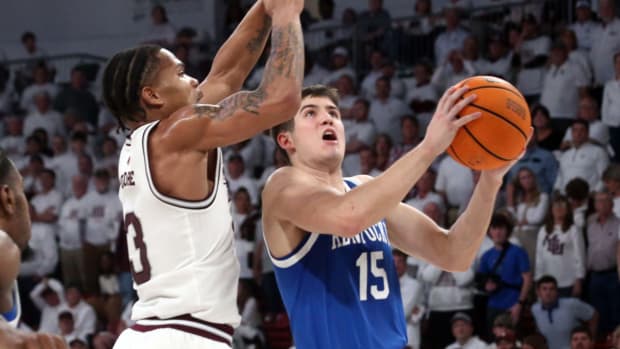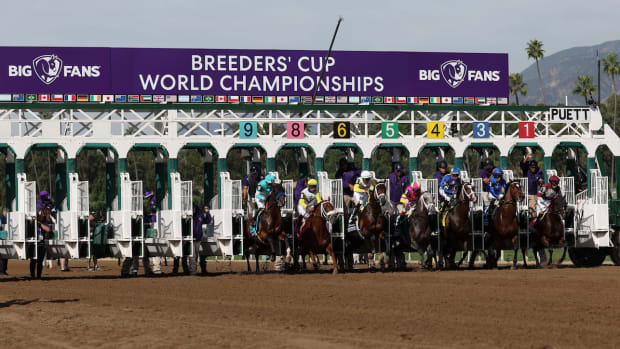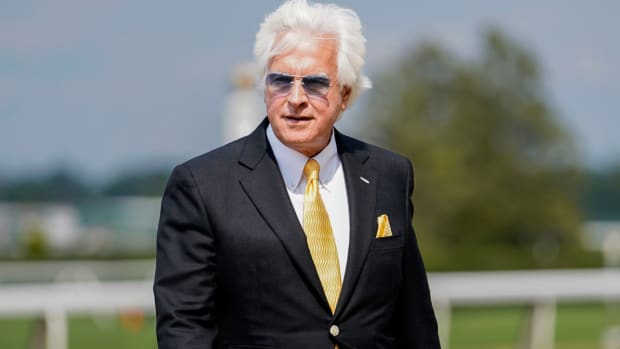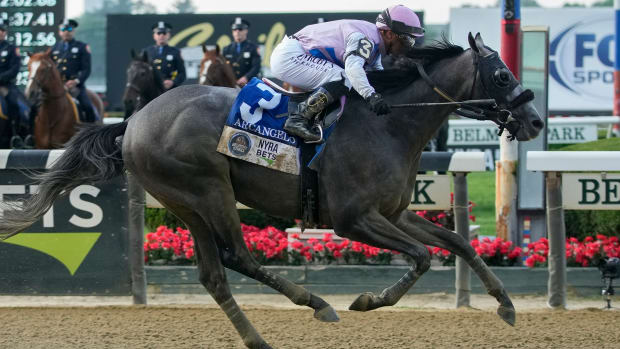It's Instinctive to Compare Justify's Triple Crown to American Pharoah's but Both Share Connection to Greatness
ELMONT, New York—History writes a chapter for each of them and the book of the Triple Crown becomes longer and richer. A tale for the horse from a century ago, the very first. Tales for the three in the 1930’s and the four in the forties, golden ages both. For Big Red most of all, and for Slew and Affirmed. And for the sleek bay colt who three years ago ran wire-to-wire in the setting sun and lifted a curse that had lingered for nearly four decades. The earth shook beneath Belmont Park that day, because the sport had waited so long and wanted it so much. They could not have known that the next would come so soon and so remarkably. They could not have known that there is always more that we can surrender to greatness when greatness arrives. And so: Again.
This time the horse’s name is Justify. He is a tall, muscular chestnut-colored colt, the type of horse that painters paint and sculptors cast. There is room for him because on another Saturday evening, in the same long shadows that have framed so many champions before, Justify won the 150th Belmont Stakes and racing’s 13th Triple Crown. And because it was unlike any that came before it. He is just the second horse, and the first since Seattle Slew in 1977, to win the Triple Crown while undefeated. His perfect record has been written in a frenetic six-race career that began only on February 18—a breakneck 112 days from first race to Triple Crown—breaking every rule, even in an evolving sport, that governs the meticulous development of top horses. The architect of this furious, unlikely rush to immortality was trainer Bob Baffert, 65, who also trained American Pharoah to his Triple Crown three years ago and is the second trainer in history—after Sunny Jim Fitzsimmons in the 1930s – to win two Triple Crowns.
“Unbelievable training job, one of the greatest of all-time” said Chad Brown, who trained Gronkowski to a runner-up finish at 25-1 odds. “Just adds to another incredible accomplishment to an incredible career.”
Baffert saw it another way. He saw Justify as a gift to be honored with his best work. His voice cracked in the post-race press conference as he sought words to describe the last four months, and in a sense, all the years that came before them. “It’s a privilege to have a horse like this,” said Baffert. “I just wanted to see his name up there, with those greats, winning the Triple Crown.” Baffert is old enough to have accumulated scars that sting more on emotional days, whether good or bad. “I was thinking about my parents,” he said after the Belmont. They died a year apart less than a decade ago. And more: “I think about friends I’ve lost.” And finally: “To train a horse like this…He’s just a magnificent animal.”
Justify was bought and guided to Baffert by a multi-pronged and complex group of owners in which Kentucky’s WinStar Farm has controlling ownership, with smaller pieces held by the mysterious China Horse Club, Boston-based hedge fund manager Sol Kumin and Louisville-based Starlight Racing (the latter two do not have rights to the considerable funds that will be generated later by Justify’s stallion career). His jockey is Mike Smith, a physical marvel at age 52, who climbed aboard Justify in his second race on March 11, and has not lost.
Justify led for every step of the grueling 1 1/2 miles of the Belmont, a distance longer than he will run again (in what is likely to be a very brief further racing career). In this way, the race was a rerun of American Pharoah’s victory in 2015, a long gallop around the massive oval called Big Sandy, towing a field of lessers in his wake whose jockeys and trainers were left with an impossible conundrum. Pressure early and risk collapse, or hope that Justify’s schedule would catch up to him and make him vulnerable in the last quarter-mile. Four hours before the race, Baffert stood in the saddling paddock and said, “Anybody who goes with him is sacrificing themselves.”
None of the others chased. Entering the turn, Smith asked for run from Justify and he opened two lengths on the fading Restoring Hope, who is also trained by Baffert (and was mysteriously close to the lead) and the approaching Vino Rosso. Piloting like a race car driver, Smith let off the gas and Justify relaxed. “He gets into that rhythm,” said Smith. “He takes a little breather and then he goes again. If I wanted him to relax I would just drop my hands and if I wanted to him to go I would just squeeze on him a little bit.”
Smith squeezed at the head of the stretch and again the big horse opened two lengths. Vino Rosso drifted out and let Gronkowski through on the rail. Hofburg got into his best stride with 300 yards left. Smith waved his stick at Justify and then hit him, four times in the last three-sixteenths. A roar built, as it had with Pharoah. Smith breezed past the line, scrubbing on Justify’s mane, 1 3/4 lengths clear of Gronkowski. In a second-floor box above the line, Baffert pumped his fist and hugged his wife, Jill. As in Pharoah’s win, he was surrounded by his four grown children from his first marriage and 13-year-old Bode, his son with Jill. (And also with the Burger King mascot, for which Baffert was again paid an undisclosed sum that he said he will donate to charity; in 2015 it was $200,000.)
Because Justify’s victory came so close on the heels of Pharoah’s, it’s instinctive to compare them. To compare the noise. To compare the buzz. To compare that which cannot be fairly compared. Pharoah’s victory was a communal bloodletting that ended 37 years of desperation between Triple Crowns. Justify’s was a celebration of a singular greatness. Different. But also the same.
Or as Jill Baffert said, delightfully, just outside the winner’s circle, “It’s just as tasty.”
They had all waited for the big colt to tire, to wear down, to show signs of fatigue from his furious, compressed rush toward history. It’s the only way he would lose, because at his best, he was too good for the other horses in his generation. Those signs would never materialize. Instead, he would make those closest to him marvel at his freakish durability. They watched and waited, because it is just three weeks from the Preakness to the Belmont, but the days pass like seconds being dragged through a mudfield. On the day after the May 19 Preakness, Jill Baffert sat on a bench outside Pimlico’s stakes barn. “It’s such a long three weeks,” she said, stretching her arms overhead and then breathing a deep sigh.
Nine days passed, and 12 days remained until the Belmont Stakes. It was a Monday morning, Memorial Day in Louisville and Baffert pointed his rented Infiniti SUV east toward Lexington on Route 64. That morning he had watched Justify gallop a feisty 1 3/8 miles alone at Churchill Downs, where he returned after the Preakness and remained until the Wednesday before the Belmont. The big horse wanted more. “He was all cranked up afterward,” Baffert said. “He needs to do something.” Baffert decided to go ahead with plans to work Justify the next day. Then a man who suffered a heart attack six years ago bravely scarfed down a plate of fried chicken and gravy at a Cracker Barrel restaurant near the racetrack.
Afterward Baffert swung his vehicle into the left lane and eased up to a speed just south of 80 miles an hour. His destination was Coolmore’s Ashford Stud in Versailles, Kentucky, where he would visit American Pharoah, in part for an NBC feature story, but also because he likes to visit Pharoah, who connects him—and the sport—to a remarkable time. Horses like Pharoah and Justify transport the people around them. They transport the entire sport.
Remembering Chic Anderson’s Legendary Call of Secretariat’s Record Run at 1973 Belmont Stakes
Baffert eagerly narrates his own tale. As the rolling Kentucky hills rushed past the windows of the SUV, he drifted back to Nogales, Arizona, where he was one of seven children born to Bill and Ellie Baffert. His dad raced horses on farm fields and Bob was often the jockey, a skinny, fearless adolescent. “One day, I was riding this horse and he went straight toward the barbed wire fence,” says Baffert. “I’m thinking, ‘This is really, really, really gonna hurt.’ But they always say give a horse his head, let him see the fence and he’ll turn away. I gave him his head and damn, he turned away. Oh, man.” Years later, he saw the wife of a good friend killed while exercising a quarter horse in Prescott, Arizona. It’s been a long ride, and now he stood on the precipice of a second Triple Crown, wealthy and famous.
He shook his head. “It did not start out like this,” he said. “Not even close.”
He met up with Pharoah in the early afternoon. At the end of his career, after the Breeders’ Cup Classic in October of 2015, American Pharoah weighed 1,175 pounds, now 1,391, softer but still shimmering. He breeds to more than 200 mares a year, which, easy jokes aside, is an exhausting schedule. But his demeanor has changed little. Baffert stroked his neck. “He loves humans,” he said. “Justify doesn’t love humans. He’ll give you about four or five seconds and that’s it.”
They are athletically dissimilar, as well, the old champion and the new one. “Pharoah looked like a European horse,” said Baffert. “Beautiful, lean body, perfectly balanced. He could run all day. Justify has muscle on muscle. He’s like LeBron James. Pharoah was like Michael Jordan.”
Justify was shipped by WinStar Farm to Baffert’s care late last fall. Minor injuries had prevented him from running the major two-year-old races. He started in a barn at Los Alamitos Race Track, south of Los Angeles, where Baffert boards many of his rookies upon arrival. In January he was moved to the big barn at Santa Anita and on Jan. 29, Baffert worked him five furlongs. “Owners wait for me to make the call and tell them they’ve got a good horse,” says Baffert. “I made some calls that day.” There were just 97 days to the Kentucky Derby and most contenders had already logged multiple races. Baffert decided to put the process in the microwave.
He ran Justify in a seven-furlong race on Feb. 18 at Santa Anita, under 23-year-old jockey Drayden Van Dyke, who got Justify into an unnecessary speed duel. “I thought, ‘Sh--, he’s done,’’’ says Baffert. “And then at the quarter pole, he just explodes again. I was like, ‘Wow, this is a serious horse.’’’ Baffert replaced Van Dyke with Mike Smith, 52, who once housed Van Dyke in his Southern California home while Van Dyke adjusted to life in a new city.
Baffert and Smith have shared a tumultuous—but not unusual—trainer-jockey relationship. It started in earnest 16 years ago when Baffert put Smith on a beastly two-year-old named Vindication, who went unbeaten and won the Breeders’ Cup Juvenile. In the winter, Baffert replaced Smith with Jerry Bailey and promised Smith, “I’ll make it up to you someday.” (Vindication was injured and never ran again.) They went on and off for a decade and a half, until Baffert, with no other options, put Smith on Arrogate in 2016 and together they went on a four-race tear. On Justify, Smith won an allowance, the Santa Anita Derby and then the Kentucky Derby, the first horse in 137 years to have won the Derby without having raced as a two-year-old.
Justify Emerges From the Fog at Preakness to Keep Triple Crown Pursuit Alive
Just before the post-race press conference, Baffert said to Smith, “You remember Vindication?” Smith nodded. Baffert said, “We’re even, dude.”
Smith says, “Bob put me on the bench for a while. But we kept talking. You always, always, always keep the lines of communication open,” says Smith. “Never burn a bridge.”
Three years ago, Baffert asked at least three jockeys to ride American Pharoah before settling on Victor Espinoza. He watched Espinoza struggle with the spotlight and become distracted by money-making offers. “Victor actually did a great job with the horse,” says Baffert. “But he had a lot of things going on.” Baffert was determined to help Smith manage the pressure. On Preakness Day, Baffert put Smith on another of his talented three-year-olds, Ax Man, to win the Sir Barton Stakes. “I thought Mike was a little nervous,” Baffert said. “I wanted to give him a spin around there before the Preakness.”
(Baffert also thought about entering Ax Man on a race on Belmont Day, but the problem was that Ax Man had upset Justify on van rides to and from Pimlico. Baffert didn’t want to risk similarly aggravating his high-strung superstar, so Ax Man was sent back to California to wait for a race at home. Smith got his winning warmup ride on Abel Tasman in the $750,00 Ogden Phipps. Smith expressed a desire to ride Baffert’s Hoppertunity in the 1 1/2-mile Brooklyn Invitational, but Baffert slammed that door. “I told Mike, `You’re getting old, you don’t need to ride two 1 1/2-mile races in the same day. I need you fresh.’” Baffert was only half-kidding.)
On the day after Baffert’s trip to Lexington, 11 days out from the Belmont Stakes, Baffert watched from a balcony in front of a luxury suite above the finish line as Justify prepared for his half-mile work. Rain bled down from grey skies as Baffert ducked under an overhang. “I’m nervous,” he said. Justify’s Preakness had been courageous, but not dominant. Some handicappers called it a sign of fatigue. Baffert said Justify needed a tough effort, and compared it to American Pharoah’s Kentucky Derby, a grinding victory that laid the foundation for stellar performances in the Preakness and the Belmont. “The Preakness will make [Justify] better,” Baffert said before this workout. But he wanted validation.
For the workout, he had flown in Martin Garcia, his top exercise rider. At 7:28 Garcia steered Justify onto the track, which was nearly empty. “Chilito,” said Garcia. It’s a word with some vulgar connotations, but in this case, Baffert and Garcia employed it to mean that Justify was calm and relaxed.
Moments later Justify scored four furlongs, effortlessly, in less than 47 seconds. Baffert watched through binoculars. “Beautiful, beautiful,” said Baffert. “Awesome. Just awesome.” Pause: “Not nervous anymore.”
As Baffert hustled out of the suite and into an elevator with David Hanley from WinStar, Garcia called on their team radio. “Chingon, patron,” said Garcia. It was the same term he had used with Pharoah after a similar workout three years earlier, also with some ugly connotations but in other ways, loosely translated: Strong. Tough. Badass.
Remembering William Nack: A Passionate, Personable Master of His Craft
Six days later Justify worked again at Churchill, this time more slowly, which Baffert said was intentional. He galloped twice at Belmont Park, aggressively. Leaving the track on Friday morning, exercise rider Humberto Gomez said to Baffert, “He loves the track. Loves it.” Justify’s rush through the Triple Crown had few hiccups. There was a heel bruise incurred in the mud in his second race, and accidentally made public when Baffert took him for a photo op on gravel outside his Churchill Downs barn.
With any and every Triple Crown attempt, there can be a whiff (or in some cases, lungs full) of controversy. This year Justify’s owners elected not to enter Florida Derby winner and third-place Kentucky finisher Audible, who they also own, in the Belmont, a move that some racing pundits viewed as cheapening Justify’s accomplishment.
A Belmont week story in The New York Times brought tension of a different sort, reporting that a bloodstock fund owned by George Soros, a frequent target of conservative media and voters, had been among the original buyers of Justify and retained a 15% share in his breeding rights, which reportedly will be sold for $75 million to Coolmore. Because this is America in 2018, this news gained traction in ugly corners of social media, wishing ill upon a horse who has no idea who owns him. (Those posting in this manner would perhaps be mollified if they understood that on Team Justify, there is significant support for Donald J. Trump.)
But on the second Saturday in June of 2018, it was, as ever, about the horse. Early Saturday morning, Baffert visited Justify in his stall in Barn One on the Belmont backside. What was he like? It was mid-afternoon by now and Baffert was standing under a canopy of spring trees in the Belmont paddock, wearing a new, custom-made sports jacket from the appointment-only Beverly Hills shop, Bijan. He considered the question, raised both eyebrows and looked over the top of his ubiquitous sunglasses. “He’s ready,” said Baffert. “So ready.”
In a post position draw four days before the Belmont at the Mets’ Citi Field in Queens, Justify had drawn the No. 1 (inside) post position, which is potentially disadvantageous, even in a race as long as the Belmont. Baffert said his instructions to Smith, starting from the inside post position, had been both obvious and stated. “Gotta go,” said Baffert. He has a healthy respect for the troubles that can befall a horse on the rail in the gate. “Step back, stumble, breaks sideways,” he said. “But Mike is good in there.”
SI 60 Q&A: William Nack on what 'Pure Heart' and Secretariat mean to him
The starting gate slammed open at 6:50 and Justify broke alertly—“Maybe the best he’s ever broken for me,’’ said Smith—and also hard to his left. The gate is placed a distance from the inside rail, so there is room for a horse to break left. Smith nudged Justify into the lead approaching the first turn. It had been speculated that Noble Indy might push the pace. He is owned in part by Mike Repole, who might have been interested in softening up Justify for Vino Rosso, who he also owns, in part. But WinStar also owns part of Noble Indy, and might not want to soften up their potential Triple Crown winner. Whatever the case, nobody tried to pressure Justify.
This was frustrating to some trainers with horses that needed a tired Justify in the homestretch, but lacked a horse with early speed. “There was no pace and nobody put any pressure on the horse,” said Bill Mott, trainer of third-place finisher Hofburg. “He kind of walked the dog around there. You can’t doubt [Justify] now. He’s probably a great horse. Everybody had an opportunity to take their shot. They let it go too easy.”
It started less easy than Baffert and Smith might have liked, the first quarter-mile in 23.37 seconds. “A little quick,” said Baffert. Smith slowed the second quarter to 24.64 and the third to 25.10, resting. At this staging barn before the race, Baffert had said he wanted three-quarters of a mile in “One-thirteen or one-fourteen.” Justify passed three-quarters in 1:31.21. There was no chance of catching him at that pace.
Gronkowski, who opened on the morning line at 12-1 and was ignored up to 25-1 in the final betting, broke horribly and fell 12 lengths behind on the first turn. (Baffert, meanwhile, was thrilled to have snagged a photo of minority owner Rob Gronkowski with Bode, in the pre-race paddock.) Under jockey Jose Ortiz, Gronkowski cut the second corner, slipped inside Vino Rosso and ever so briefly seemed to have a shot. That shot vanished when Smith asked Justify for more. His winning time was 2:28.18, a second and a half slower than Pharoah, but more than respectable.
So as darkness fell on the Belmont Park, the Triple Crown near-misses of the '80s, the '90s and the 2000s receded further from memory, old wounds healed over, nearly forgotten. Three years ago the curse was ended and a sport felt relief. On Saturday it happened again and that same sport found adulation. This much we know: The feeling will never get old.











